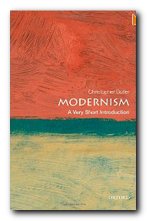radical developments in the arts 1900-1930
As a critical term ‘modernism’ needs careful use and understanding. For it refers not to things that are modern, but to the general movement of experiment in the arts that took place in the period 1900-1930. Modernism is the loose term we use for discussing Stravinsky’s The Rite of Spring, Woolf’s Mrs Dalloway, and Picasso’s Les Demoiselles d’Avignon. Christopher Butler offers as background reasons for these radical artistic developments the loss of religious belief, the growth of science and technology, the spread of mass culture, and radical changes in gender roles and relationships.
 He starts his survey of the period very wisely by presenting and analysing three iconic modernist works – James Joyce’s Ulysses, Fernand Leger’s La Ville, and Berthold Brecht’s The Threepenny Opera, explaining how they ‘work’ in terms of their use of new techniques including fragmentation, collage, strange juxtapositions, abstraction, parody, allusions, and referentiality.
He starts his survey of the period very wisely by presenting and analysing three iconic modernist works – James Joyce’s Ulysses, Fernand Leger’s La Ville, and Berthold Brecht’s The Threepenny Opera, explaining how they ‘work’ in terms of their use of new techniques including fragmentation, collage, strange juxtapositions, abstraction, parody, allusions, and referentiality.
Then he looks at the theories that were advanced as attempts to underpin these developments. This is a tricky area, because what artists say or claim about their own work is not necessarily to be taken at face value. There are other problems too. Picasso and Braque for instance invented cubism without writing a single word explaining the process.. Many other artists on the other hand wrote manifestos full of complex notions and theories that turn out to be entirely unconnected with the works of art they produced.
Schoenberg thought his twelve tone system would assure the dominance of world music by Germany for the next one hundred years [sounds familiar?] but within a short time most listeners had tired of atonality. Writers such as Joyce, Woolf, and Eliot fared better in explaining their methods because literature is a medium which must faux de mieux be articulated via language.
The range of Butler’s references and examples discussed is enormous – though I was not persuaded by his attempts to recruit Wallace Stephens and William Faulkner into the Pantheon of Significance. It’s surprising how quickly some artistic reputations fade or in some cases are revealed as completely bogus – Wyndham Lewis, Aldous Huxley, Herman Broch, Andre Gide, and Gertrude Stein spring to mind as candidates.
He devotes an entire chapter to the creation of a subjective point of view and its counterpart in modern fiction, the Epiphany. Literature naturally dominates here, but he compensates for this by including a section on surrealism, in which painting is the main art form. Interestingly enough, even though it was a short-lived phenomenon, it still lives on in occasional appearances in the visual arts, whereas in literary forms it is as dead as the dodo.
He brings all his arguments together with a quite refreshing examination of modernism and politics. This starts with the surrealists who half-heartedly tried to ally themselves to the Communist Party, then passes on to show how the communist orthodoxy of Socialist Realism chimed exactly with the Nazi policy on the arts. He also includes a lively critique of Berthold Brecht, who often escapes censure for his Stalinist propaganda, disguised as it often is beneath historical allegory.
He concludes with arguments that are quite contemporary in their scepticism. No matter which critical approach we take for instance, it is simply not possible to say which parts of Women in Love, The Firebird, or Guernica are ‘progressive’ or contribute to social development or enrichment. But what is more interesting is that these great modernist works still speak to us as vibrant examples of artistic achievement long after the historical and political events that provide their context have passed.
© Roy Johnson 2010
Christopher Butler, Modernism: a very short introduction, Oxford: Oxford University Press, 2010, pp.117, ISBN: 0192804413
More on art
More on media
More on literature
More on the novella